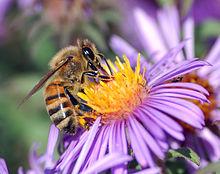
Back Ашьхыц Abkhazian Heuningby Afrikaans Europäische Honigbiene ALS نحل العسل الغربي Arabic نحل العسل الغربى ARZ Apis mellifera AST Bal arısı Azerbaijani Imp BAR Bėtės BAT-SMG Меданосная пчала Byelorussian
L'ape europea o ape occidentale (Apis mellifera Linnaeus, 1758) è la specie del genere Apis più diffusa nel mondo.[1][2]
Si crede che tale specie abbia avuto origine in Africa[3] o in Asia[4] e che si diffuse attraverso l'Africa, il Medio Oriente e l'Europa.[5] Gli esseri umani hanno esteso il loro areale, introducendo sottospecie europee in Nord America (primi anni del XVII secolo),[6] in Sud America, Australia, Nuova Zelanda e in Asia orientale.[7] Attualmente si trova in ogni continente eccetto l'Antartide.[5]
Dopo aver scelto il nome Apis mellifera ("portatrice di miele") nel 1758, Linneo propose nel 1761 il più tecnicamente corretto Apis mellifica ("produttrice di miele"), nome ancora usato da alcuni autori.[8][9]
- ^ Michael S. Engel, The taxonomy of recent and fossil honey bees (Hymenoptera: Apidae: Apis), in Journal of Hymenoptera Research, vol. 8, 1999, pp. 165–196.
- ^ N. Lo, R.S. Golag, D.L. Anderson e B.P. Oldroyd, A molecular phylogeny of the genus Apis suggests that the Giant Honey Bee of the Philippines, A. breviligula Maa, and the Plains Honey Bee of southern India, A. indica Fabricius, are valid species, in Systematic Entomology, vol. 35, n. 2, 2010, pp. 226–233, DOI:10.1111/j.1365-3113.2009.00504.x.
- ^ Charles W. Whitfield, Susanta K. Behura, Stewart H. Berlocher, Andrew G. Clark, J. Spencer Johnston, Walter S. Sheppard, Deborah R. Smith, Andrew V. Suarez, Daniel Weaver & Neil D. Tsutsui, Thrice out of Africa: ancient and recent expansions of the honey bee, Apis mellifera (PDF), in Science, vol. 314, n. 5799, 2006, pp. 642–645, Bibcode:2006Sci...314..642W, DOI:10.1126/science.1132772, PMID 17068261 (archiviato dall'url originale il 29 settembre 2015).
- ^ Fan Han, Andreas Wallberg e Matthew T Webster, From where did the Western honeybee (Apis mellifera) originate?, in Ecology and Evolution, vol. 2, n. 8, 2012, pp. 1949–1957, DOI:10.1002/ece3.312, PMC 3433997, PMID 22957195.
- ^ a b Ashley N. Mortensen, Daniel R. Schmehl e Jamie Ellis, European honey bee, in Entomology and Nematology Department, University of Florida, agosto 2013. URL consultato il 1º settembre 2018.
- ^ Research upsetting some notions about honey bees, ScienceDaily, 29 dicembre 2006.
- ^ M. Winston, J. Dropkin e O. Taylor, Demography and life history characteristics of two honey bee races (Apis mellifera), in Oecologia, vol. 48, n. 3, 1981, pp. 407–413, Bibcode:1981Oecol..48..407W, DOI:10.1007/bf00346502, PMID 28309760.
- ^ (EN) T. A. Dettlaff e Sergei G. Vassetzky (a cura di), Animal Species for Developmental Studies, Volume 1 Invertebrates, Dordrecht, Springer Science & Business Media, 2012, p. 204, ISBN 978-1-4613-0503-3, OCLC 958562111. URL consultato il 20 maggio 2018.«The honeybee Apis mellifera Linaeus, 1758 (sometimes called Apis mellifica Linnaeus, 1761)»
- ^ (EN) H. A. Dade, Anatomy and Dissection of the Honeybee, Londra, I.B.R.A. e London : International Bee Research Association, 1994, p. 28, ISBN 0-86098-214-9, OCLC 780621829. URL consultato il 20 maggio 2018.«The correct, official name of our honeybee is Apis mellifera L., which means 'the honey-bearing bee', not a very good descriptive name. It is the first name given to her by Linnaeus, and it appears in the 10th edition of his Systema Naturae (1758). Later, he changed the name to Apis Mellifica.»


